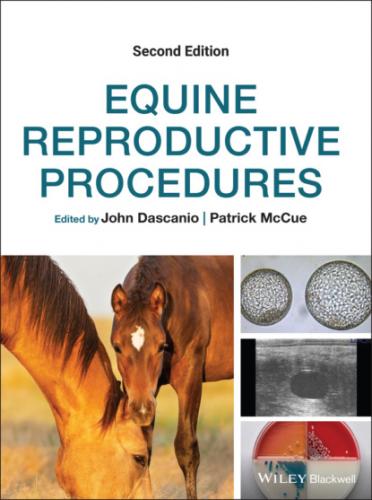Introduction
Biopsy of the uterine lining or endometrium is primarily used in the evaluation of uterine health, detection of uterine disease, and as a prognostic indicator of the ability of a mare to carry a foal to term. Endometrial biopsies are collected as part of a routine breeding soundness evaluation, as part of a pre‐purchase evaluation of a potential broodmare, and in the examination of barren mares, problem breeding mares, and mares with a history of pregnancy loss. Samples may be collected prior to the onset of the breeding season, during the breeding season, or at the end of the breeding season. A biopsy may be collected during any stage of the estrous cycle, although individual veterinarians may prefer to collect samples when the mare is either in diestrus or in early estrus. It is important to record the stage of the mare’s estrous cycle so that the pathologist evaluating the biopsy sample can interpret the architecture accordingly.
Endometrial biopsy samples may also be used for microbiological culture, cytologic evaluation, and detection of microbial DNA using reverse transcription polymerase chain reaction (RT‐PCR) techniques.
Equipment and Supplies
Uterine biopsy instrument, sterile obstetrical sleeve, sterile obstetrical lubricant, formalin (10%) or Bouin’s solution, alcohol (70%), 25 gauge needle to tease biopsy out of instrument.
Technique
An ultrasound examination is recommended prior to biopsy collection to confirm that the mare is not pregnant and to help stage the mare’s estrous cycle.
The tail of the mare is wrapped and held out of the way (see Chapter 4).
The perineal area is thoroughly cleansed using a non‐residual liquid soap, rinsed with clean water, and dried with paper towels (see Chapter 3).
A sterile obstetrical sleeve with sterile lubricant is worn by the examiner.
An endometrial biopsy instrument is held in a closed position within the hand, guided into the vagina, and then carefully passed through the cervix into the uterus.
The examiner generally removes the arm guiding the biopsy instrument from the vagina and inserts the arm into the rectum to manually aid in placement of the instrument in the correct location. The biopsy location is usually at the base of one of the uterine horns or in an area of suspected pathology.
The examiner then opens the cutting basket of the instrument and applies gentle ventral pressure on the rectum to push endometrial tissue inside the cutting basket. (Figure 19.1).Figure 19.1 Endometrial biopsy instrument passed into the uterus of the mare. The basket is in the open position to take a sample.
The instrument is closed, collecting a small sample (0.25 × 1–2 cm) of endometrial tissue.
The biopsy sample is placed into fixative solution (i.e., 10% formalin or Bouin’s solution). A 25 gauge needle may be used to tease the sample out of the basket of the instrument. The container should be labeled with the name of the mare, collection date, and other pertinent information. If the biopsy sample is initially fixed in Bouin’s solution, it should be transferred into 70% alcohol the following day.
The fixed biopsy specimen is submitted to a pathology laboratory.
A single biopsy sample collected from one site is generally representative of the entire endometrium. However, collection of multiple samples may be advantageous in mares where a long‐standing infertility is present to better characterize the endometrium.
The owner may be warned that the mare may have a slight vulvar hemorrhagic discharge post‐biopsy for the first 24 hours.
Biopsy Interpretation
Histologic characteristics of the biopsy vary with the season and stage of the estrous cycle. Endometrial glands are inactive during seasonal anestrus and the luminal and glandular epithelial cells are either cuboidal or squamous. During estrus, the epithelial cells are usually columnar to tall columnar and considerable edema is present in the lamina propria. During diestrus, the epithelium varies from columnar to cuboidal, edema is absent, and the glandular branches are usually tortuous.
Figure 19.2 Endometrial biopsy from a mare with endometritis. Note the lymphocytic inflammatory cells infiltrating the endometrium (arrow).
Endometrial biopsy samples are examined for the presence of inflammatory and degenerative changes. Inflammation is recognized by the accumulation of inflammatory cells in the endometrial tissue (Figure 19.2). Acute inflammation is recognized by the presence of polymorphonuclear leukocytes, whereas chronic inflammation is characterized by the presence of lymphocytes and other mononuclear cells in the endometrium. Inflammation may be infectious or non‐infectious in origin, but is a potentially treatable pathologic condition which may respond to intrauterine or systemic therapy.
Endometrial glandular degeneration is most often recognized by a deposition of collagen in the form of fibrosis or scar tissue around the endometrial glands, often forming what are called glandular “nests.” Other degenerative changes detected in biopsy evaluation include cystic dilation of glands, glandular necrosis, and accumulation of inspissated material within dilated glands (Figure 19.3). In contrast to inflammation, fibrosis represents a permanent, untreatable pathologic condition. In addition, a biofilm layer may be noted on the surface of endometrial biopsies collected from mares with endometritis that are fixed in Bouin’s solution (Figure 19.4). Unfortunately, a biofilm is often washed away from endometrial biopsy samples fixed in formalin.
The endometrium is classified on a grading scale based on biopsy characteristics that ranges from I to III. Grade I endometrium is essentially normal, with minimal inflammation or fibrosis. Grade III endometrium includes severe inflammatory and/or fibrotic changes. Grade II is a broad category, often divided into subcategories IIA and IIB, encompassing all pathologic levels between grades I and III. It is possible for an improvement in endometrial grade if the inflammation present is reduced or eliminated with proper treatment.
Figure 19.3 Endometrial biopsy (grade III) from a mare with severe fibrosis. Note the glandular nesting and inspissated material within the dilated glands (arrow).
Figure 19.4 Biofilm (bracket) adhered to the endometrial surface of a mare with bacterial endometritis.
Reproduced
